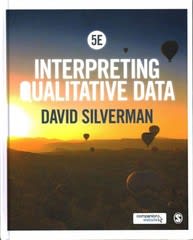Question
Use the link to listen to the NPR Hidden Brain Podcast (https://www.npr.org/2017/02/21/512035150/on-the-knifes-edge-using-therapy-to-address-violence-among-teens)Then reflect on the following aspects: Aspect A: In On the Knife's Edge a
Use the link to listen to the NPR Hidden Brain Podcast (https://www.npr.org/2017/02/21/512035150/on-the-knifes-edge-using-therapy-to-address-violence-among-teens)Then reflect on the following aspects:
Aspect A: In "On the Knife's Edge" a psychological concept was introduced to explain why people often do irrational things. The podcast shares that in many instances regret occurs as fast as anger. Identify the term mentioned and describe the concept. Then, discuss one thing that you have done that immediately led to regret, how would the concept you just described explain the irrational behavior you have identified.
Aspect B: If you had to check in right now, how would you check in using the 4 aspects described in the video? Please make sure to label the 4 aspects. How might expressing these four aspects help a person develop more awareness and promote change?
Aspect C: "On The Knife's Edge" shared information about a program called Becoming A Man (BAM). The program was designed to help young men identify and address automatic behaviors. The program results showed great success while students were in the program, throughout school. But the program recipients did not continue utilizing the behaviors after the program ended. How could this program be incorporated into a larger society? How might this service be implemented in other programs and areas?
Aspect D: As we have learned throughout the semester, there are biological, psychological, and sociological factors that impact behavior. This podcast shares information on how to address some psychological, cognitive actions that lead to violent behavior. Reflect on some of the biological and sociological factors that may also contribute to the actions of the BAM participants.
Please choose TWO of the five provided Essay prompts and thoroughly answer all aspects of the question.
OPTION A: When we look at the history of treating mental illness there are some rudimentary practices being utilized.
- Describe how mental illness was viewed and treated in over a hundred years ago.
- Based on what you have learned in this unit, what changed in treating mental illness and how did that change impact the landscape of mental health treatment? Make sure to use terms you have learned in this unit as you discuss this shift.
- One of the earlier treatment approaches for mental ailments was Freud's Psychoanalysis, briefly describe the difference between Freud's psychoanalysis and modern-day psychodynamic approaches.
OPTION B: Pete has sought out therapy to address issues he is having with his boss at work. Pete struggles to communicate with his female boss because she is very daunting. She often barks orders and intimidates Pete. Pete often feels that he isn't good enough to do what she asks and struggles with low self-esteem. It doesn't help that Pete's boss reminds him of his mother!
- Describe what aspect(s) a psychoanalytic therapist would focus on when helping Pete.
- Describe what aspect(s) a humanistic therapist would focus on when helping Pete.
- Briefly talk about the differences between a psychoanalytic therapist and a humanistic therapist.
OPTION C: Sam has been struggling with a lot of anxiety lately. He has an immense fear of snow. Unfortunately, Sam lives in Michigan and there is a lot of snow where he lives. Sam shares that when he thinks about snow, he thinks about being trapped under an avalanche and it leads to a panic attack. He ends up staying in his house when it is snowing.
- How could you use exposure therapy to help Sam overcome his fear of snow? Make sure to use appropriate terminology that you have learned in this unit.
- If Sam were seeing a cognitive based therapist how might they work to address Sam's irrational thinking? Clearly identify which therapeutic approach you are talking about and utilize appropriate terminology for that approach.
OPTION D: Biomedical approaches to therapy focus on the organic component of mental illness.
- ECT is a type of biomedical treatment for a specific illness. What is that illness and what is the outcome of using ECT? When is it decided that ECT will be used for treating this illness? If there are potential side effects, what are they?
- Tony has sought out treatment for his ongoing panic and anxiety. He would like to figure out a way to be able to get back into daily life, but the anxiety is crippling. Briefly describe TWO biomedical options for treatment and TWO non-biomedical options for treatment that you have learned about in this unit.
- Identify one pro and one con of biomedical treatment versus traditional therapeutic treatments.
Step by Step Solution
There are 3 Steps involved in it
Step: 1

Get Instant Access to Expert-Tailored Solutions
See step-by-step solutions with expert insights and AI powered tools for academic success
Step: 2

Step: 3

Ace Your Homework with AI
Get the answers you need in no time with our AI-driven, step-by-step assistance
Get Started


